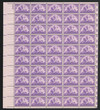
1940 3c Coronado Expedition
# 898 - 1940 3c Coronado Expedition
$0.35 - $30.00
U.S. #898
3¢ Coronado Expedition
3¢ Coronado Expedition
Issue Date: September 7, 1940
City: Albuquerque, NM
Quantity: 60,943,700
Printed by: Bureau of Engraving and Printing
Printing Method: Rotary Press
Perforations: 11 x 10.5
Color: Violet
City: Albuquerque, NM
Quantity: 60,943,700
Printed by: Bureau of Engraving and Printing
Printing Method: Rotary Press
Perforations: 11 x 10.5
Color: Violet
The 1940 Coronado Expedition stamp commemorates the 400th anniversary of Francisco Vasquez de Coronado's two-year exploration of the American Southwest. The stamp features a reproduction of Gerald Cassidy's painting, Coronado and His Captains. The top right corner of the stamp features the Coronado coat of arms.
This was the last postage stamp issued under Postmaster General James A. Farley (famous for his role in the Farley's Follies). He resigned because he disagreed with President Roosevelt's decision to run for an unprecedented third term.
U.S. #898
3¢ Coronado Expedition
3¢ Coronado Expedition
Issue Date: September 7, 1940
City: Albuquerque, NM
Quantity: 60,943,700
Printed by: Bureau of Engraving and Printing
Printing Method: Rotary Press
Perforations: 11 x 10.5
Color: Violet
City: Albuquerque, NM
Quantity: 60,943,700
Printed by: Bureau of Engraving and Printing
Printing Method: Rotary Press
Perforations: 11 x 10.5
Color: Violet
The 1940 Coronado Expedition stamp commemorates the 400th anniversary of Francisco Vasquez de Coronado's two-year exploration of the American Southwest. The stamp features a reproduction of Gerald Cassidy's painting, Coronado and His Captains. The top right corner of the stamp features the Coronado coat of arms.
This was the last postage stamp issued under Postmaster General James A. Farley (famous for his role in the Farley's Follies). He resigned because he disagreed with President Roosevelt's decision to run for an unprecedented third term.








